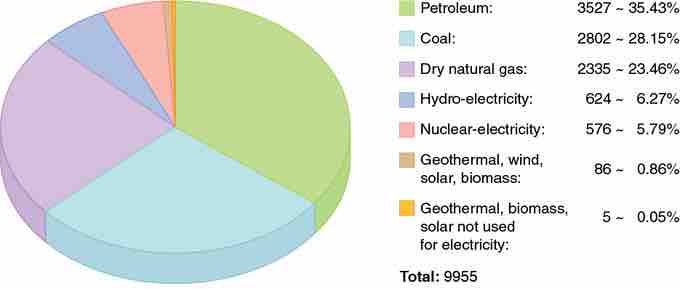Energy Use
World energy consumption is the total amount of energy used by all humans on the planet (measured on a per-year basis). This measurement is the sum of all energy sources (and purposes) in use. Who measures this? Several organizations publish this data, including the International Energy Agency (IEA), the US Energy Information Administration (EIA), and the European Environment Agency. This data is useful because evaluating this information to discover trends might yield energy issues not currently being addressed, thereby encouraging the search for solutions. The IEA established a goal of limiting global warming to 2 degrees Celsius, but this goal is becoming more difficult to reach each year that the necessary action is not taken. In global energy use, fossil fuels make up a substantial portion. In 2011 they received over $500 billion in subsidies—six times more than that received by renewable energy sources.
Implementing new practices that will utilize different, renewable energy sources is important because having access to energy is important—it maintains our quality of life. Fossil fuels, however, are not sustainable at the rate they are currently used. About 40% of the world's energy comes from oil, but oil prices are dependent on uncertain factors (such as availability, politics, and world events). The United States alone uses 24% of the world's oil per year, yet it makes up only 4.5% of the world's population! In 2008, total worldwide energy consumption was 474 exajoules (474×1018 J=132,000 TWh)—equivalent to an average power usage of 15 terawatts (1.504×1013 W). Potential renewable energy sources include: solar energy at 1600 EJ (444,000 TWh), wind power at 600 EJ (167,000 TWh), geothermal energy at 500 EJ (139,000 TWh), biomass at 250 EJ (70,000 TWh), hydropower at 50 EJ (14,000 TWh) and ocean energy at 1 EJ (280 TWh).
Types of Energy
shows a pie chart of world energy usage by category—both renewable and nonrenewable sources. Renewable energy comes from sources with an unlimited supply. This includes energy from water, wind, the sun, and biomass. In the US, only 10% of energy comes from renewable sources (mostly hydroelectric energy). Nonrenewable sources makes up 85% of worldwide energy usage—from sources that eventually will be depleted, such as oil, natural gases and coal.

World Energy Use
This chart shows that the primary worldwide energy sources nonrenewable. If new practices are not put in place now, this model will not be sustainable.
Energy Needs
In the last 50 years, the global energy demand has tripled due to the number of developing countries and innovations in technology. It is projected to triple again over the next 30 years. In Europe, many in such developing areas recognize that the need for renewable energy sources, as the present course of energy usage cannot be sustained indefinitely. While renewable energy development makes up a only small percentage of the field, strides are being made in natural energy, particularly wind energy.
For example, by the year 2020 Germany plans to meet 10% of their total energy usage and 20% of its electricity usage with renewable resources. While some countries are making improvements in this field, coal usage is still a huge problem. In China, two thirds of the energy used each year is from commercial coal energy. India imports 50% of its oil, and 70% of its electricity is produced from coal, which is highly polluting.